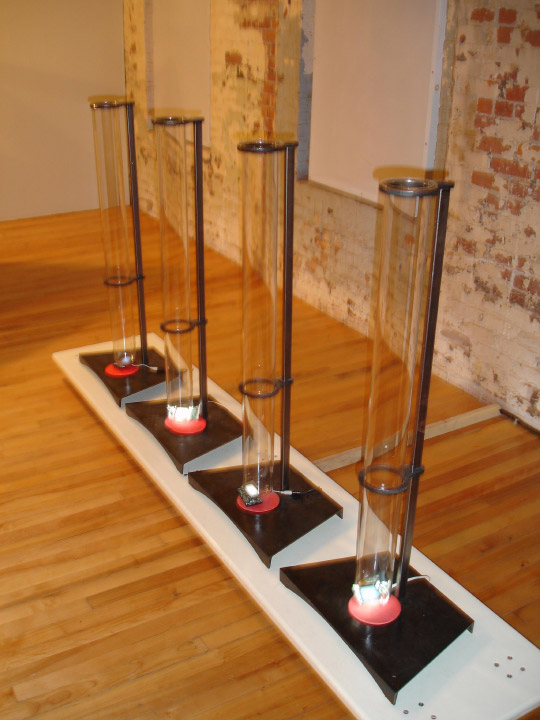 |
| Blue Morpho Butterfly |
Take for example the property of color. Being able to visualize the world in color allows us to see things with vibrancy and detail. The Blue Morpho butterfly appears to have blue iridescent wings, but in actuality this blue pigment is an illusion (Gimzewski & Vesna). Known as nanophotonics, light is being manipulated through shapes at the nanoscale, making the wings appear blue (Gimzewski). This makes me wonder what other things in nature are deceiving us through nanoscale properties.
 |
| Nano-Scape |
Featured in the John Curtin Gallery in 2010 was an interactive exhibit called Nano-Scape (Art in the Age of Nanotechnology). Relying solely on touch, participants wore magnets that allowed them to feel various magnetic forces and pulls as they moved their hand across the table. The exhibit appears to be a blank table, but as the user moves his or her hands, vibrations and movements can be felt. Similar to the Scanning Microscope Telescope, this new reliance on the sense of touch is vital in nanotechnology.
 |
| An example of Orfescu's artwork |
The future sounds promising with predictions of nanotechnology being able to "turn dirt into food and end world hunger" (Gimzewski). Hopefully, this will transcend beyond media hype and manifest into concrete results.
Sources:
"Art in the Age of Nanotechnology." John Curtin Gallery, Art.Base, 2010. https://art.base.co/event/2104-art-in-the-age-of-nanotechnology Accessed 24 May 2018.
Feder, Barnaby. "The Art of Nanotech" The New York Times, Bits (Business, Innovation, Technology, Society), 25 January 2008, https://bits.blogs.nytimes.com/2008/01/25/the-art-of-nanotech/ Accessed 27 May 2018.
Gimzewski, James. "Nanotech Jim pt1." YouTube, uploaded by uconlineprogram, 21 May 2012, https://www.youtube.com/watch?v=q7jM6-iqzzE.
Gimzewski, Jim and Victoria Vesna. "The Nanomeme Syndrome: Blurring of Fact & Fiction in the Construction of a New Science." http://vv.arts.ucla.edu/publications/publications/02-03/JV_nano/JV_nano_artF5VG.htm Accessed 16 May 2018.
Gimzewski, James. "Nanotech Jim pt2." YouTube, uploaded by uconlineprogram, 21 May 2012, https://www.youtube.com/watch?v=HEp6t0v-v9c.
Gimzewski, James. "Nanotech Jim pt4." YouTube, uploaded by uconlineprogram, 21 May 2012, https://www.youtube.com/watch?v=yHCuZetAIhk
Gimzewski, James. "Nanotech Jim pt5." YouTube, uploaded by uconlineprogram, 21 May 2012, https://www.youtube.com/watch?v=4OWc8nmHJmY
Image Sources:
https://dennstedt.wordpress.com/2017/11/18/one-of-natures-finest-the-blue-morpho-butterfly/ Accessed 27 May 2018.
Orfescu, Cris. Light through a Pinhole No.2. https://www.interaliamag.org/articles/cris-orfescu-nanoart-atomic-molecular-sculptures-and-landscapes/ Accessed 27 May 2018.
Sommerer, Christa and Laurent Mignonneau. Nano-Scape. 2010. John Curtin Gallery, Perth. https://art.base.co/event/2104-art-in-the-age-of-nanotechnology. Accessed 24 May 2018.









